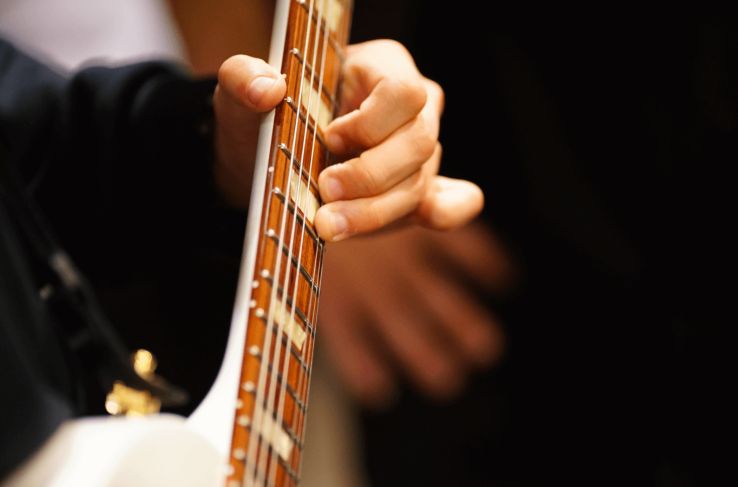5 Blues Guitar Licks From The Pentatonic Scale You Should Know
by Tom Hess
Emotion To Any Guitar Lick

EMAIL TO GET ACCESS
By submitting your info, you agree to send it to Tom Hess Music Corporation who will process and use it according to their privacy policy.
If you like blues guitar, this article may well be the best thing you read today.
Here is why:
I'm going to show you 5 awesome blues guitar licks from the pentatonic scale.
These are licks every guitarist should know.
You can use these blues guitar licks in your next lead guitar solo.
And when you do, these blues guitar licks help you squeeze maximum emotion from the pentatonic scale and insert more feeling into your lead guitar playing.
Best part?
They are simple to play.
(Even if you haven’t been playing lead guitar for very long.)
All you need to start is...
...be able to play at least one shape of the pentatonic scale.
To begin, watch the video below:
After you learn these pentatonic guitar licks, here is how to practice them to make your blues guitar solos sound even better:
Blues Guitar Practice Tip #1: Learn The Pentatonic Scale All Over The Guitar. Here Is How:
Tell your average blues guitar player to play a pentatonic scale and where do their fingers go?
You got it:
To the 6th string 5th fret. And they play the A minor pentatonic scale – as if it’s “the” default blues guitar scale position.
Emotion To Any Guitar Lick

EMAIL TO GET ACCESS
By submitting your info, you agree to send it to Tom Hess Music Corporation who will process and use it according to their privacy policy.
And that means:
There are 5 pentatonic scale positions you better know (each starting from one of the 5 pentatonic scale notes).
And if you want to play blues guitar really well – you better memorize all 5.
The good news is: there are only 5 pentatonic scale shapes to learn.
Once you learn them – you can play blues guitar in all 12 keys.
And you’ll be able to create your own guitar licks from the pentatonic scale – similar to the ones I showed you in the blues guitar video you just watched.
Question: “Tom Hess, what’s the best way to practice memorizing pentatonic scale positions on guitar?”
Answer: There is no “best” way – but there are many good ways.
Here are a few of them:
- find the fingerings for the pentatonic scale patterns, so your fingers don’t have to guess what notes to play.
- practice this skill consistently. Meaning: it’s better to practice memorizing pentatonic scale shapes for 10 minutes per day every day than to work on this area of your lead guitar playing for an hour once per week.
On that note:
- use your time away from the guitar to memorize pentatonic scale shapes faster. The way you do it is: imagine your right forearm is a fretboard. Put your left hand on the right forearm and imagine you are playing pentatonic scale patterns. This forces you to think about the notes and burn pentatonic scale shapes into your “lead guitar brain”.
This approach works great for memorizing any and all lead guitar scales – not just pentatonic scale shapes.
For example, check out this lead guitar lesson about memorizing major scales patterns:
Question: “Tom Hess: should I put the rest of my blues guitar playing on hold until I fully memorize the 5 shapes of the pentatonic scale?”
Answer: No, definitely not. To play blues guitar well, you need a whole arsenal of lead guitar skills. And it’s best to practice them in a geometric way. Meaning: make some time for all blues guitar skills throughout each week of your guitar practice.
This is the fastest way to reach your lead guitar playing goals.
Blues Guitar Practice Tip #2: Refine your Lead Guitar String Bending Technique. Here Is How:
You can’t play blues guitar well without mastering string bends. (No matter how many guitar licks you learn from the pentatonic scale.)
Here is how to learn blues guitar string bends:
1. Understand blues guitar string bending mechanics. It starts with the “blues guitar” hand position. Meaning: wrap your thumb around the fretboard when you play blues guitar string bends. This is the position to use when you play guitar licks from the pentatonic scale I showed you in this article.
With your hand in the right position, rotate your arm to bend the string, as if you are turning a doorknob. A proper blues guitar string bending motion looks like this:
Question: “But Tom Hess, I heard you are supposed to keep your thumb behind the fretboard when you play lead guitar. Isn’t that true?”
Answer: Yes and no. You do keep your thumb behind the guitar neck when playing most scales, arpeggios and guitar licks that require stretching.
But bring your thumb over the guitar neck when playing blues guitar, bending strings or playing most licks from the pentatonic scale.
This is one of the keys to making all your pentatonic scale lead guitar playing sound good. And here is what that blues guitar hand position looks like:

2. Mute string noise. Sloppy lead guitar playing never sounds good – especially in blues guitar solos. This applies to the pentatonic scale licks you learned in this article.
Here are my favorite ways to mute excess string noise when practicing string bends:
Use thumb muting.
Rest your picking hand’s thumb on the thicker strings when you play the pentatonic scale guitar licks I showed you. Slide the thumb up and down the strings as you change strings & improvise blues guitar solos.
This keeps the lower (in pitch) strings muted as you bend strings. Thumb muting is a great way to mute sloppy noise in all lead guitar playing (including the pentatonic scale guitar licks from this article).
Here is what thumb muting looks like and how to do it when you practice your pentatonic scale guitar licks:
Question: “Tom Hess, isn’t it better to mute with the palm of your hand when playing lead guitar?”
Answer: No. There are many reasons and one of them is: when you mute with your palm, your pick is at rest outside the string trench (space between strings). This makes your picking less efficient. And this affects your lead guitar playing even if you are playing slow guitar licks from the pentatonic scale.
When you mute with the thumb – your pick is at rest between strings and your playing becomes a lot more efficient and accurate.
Use the index finger of your fretting hand.
Your index finger lightly touches the higher (in pitch) strings as you do a string bend. This way your blues guitar licks stay clean from both directions (higher and lower).
3. Make sure to keep your string bends in tune.
Nothing ruins a blues guitar solo faster than out-of-tune string bends. This is especially true for the pentatonic scale lead guitar licks I showed you.
How do you practice keeping string bends in tune?
Simple:
Choose a note in the pentatonic scale you want to bend up to. Play that note as an unbent note to get its sound into your ear. Then start doing a string bend into the note you just played.
Your goal is to stop bending the moment you are sure the note is in tune.
Do the string bend very slowly to give your ear the time to tell if you are bending the string in tune. This is how you train your blues guitar string bending technique.
If you forget what the target note (of your lead guitar string bend) is supposed to sound like, simply play it again.
Bonus lead guitar tip: this exercise is also a great blues guitar phrasing technique. I call it: “re-articulation” of a string bend. What you do is: play any note in the pentatonic scale and then bend right into it.
You can add this great lead guitar ornament to any note in your blues guitar solo.
Blues Guitar Practice Tip #2: Master Your Lead Guitar Vibrato
Vibrato is the heart & soul of great blues guitar playing.
You can breathe life into all your guitar licks simply by improving your vibrato and…
…using it more expressively in your blues guitar solos.
Here are my best lead guitar vibrato tips to make your guitar licks sound better:
1. Use the same “thumb-over-the-neck” position for lead guitar vibrato as you did for blues guitar string bends. This gives you maximum control when adding vibrato to your pentatonic scale guitar licks.
2. Don’t shake the string from side to side. Instead, bend the string up and down. This is the secret to getting control over your vibrato and getting a real rock lead guitar sound.
The last thing you want is a fast & narrow out-of-control vibrato!
3. Don’t do vibrato with your fingers. Instead, do the motion with the entire arm. The vibrato motion is almost the same as the motion for lead guitar string bends. Only when you do vibrato, you move the string fast. And ideally, your vibrato should also be in time with the beat of the music. Here is what I mean:
4. Delay your vibrato
Most lead guitar players do vibrato instantly. That means: they play a note and add vibrato to it right away.
And you can certainly make your pentatonic scale guitar licks sound good by doing this.
The only problem? There Is more than one way to add vibrato in your guitar licks. And the more of them you know – the better you can express yourself as a blues guitar player.
My 2 favorite vibrato variations are:
- delayed vibrato (where you play a note, let it sustain for a second and then add vibrato).
- delayed vibrato with rearticulation (where you play a note, let it sustain for a second, hit the note again and then add vibrato).
Vibrato with re-articulation is very effective in guitar licks that use string bends. (And it sounds especially good in pentatonic scale guitar licks.)
That’s because you can add maximum emotion to the string bend by re-articulating the note, before adding lead guitar vibrato to it.
Blues Guitar Practice Tip #3: Add Lead Guitar Slides Into Pentatonic Scale Guitar Licks
Think you know how to do lead guitar slides?
Most blues guitar players only do ascending lead guitar slides (where they slide to a higher note from a lower note).
Fewer lead guitar players know about descending slides, where you slide to a lower note from a higher note.
(These slides aren’t any harder to play, but they add a ton of intensity to your pentatonic scale guitar licks (especially if you combine them with vibrato).)
But here are blues guitar sliding ideas very few guitarists know about:
Backslides
What are backslides?
A backslide is a lead guitar trick that consists of 3 steps you can add to any blues guitar lick:
1. You play any lead guitar note
2. You slide away from that note (up or down), to add lead guitar phrasing to it.
3. You slide back to the note you started from and continue playing other guitar licks.
Question: “Tom Hess, backslides sound the same as descending slides. Is it just a different name of the same blues guitar technique?”
Answer: No, not at all. Backslides are NOT the same lead guitar element as "descending slides". A descending slide happens when you slide to any note from a higher pitch.
Descending slides don't have 3 parts like backslides do.
That said, you can use backslides in any blues guitar solo. (And they sound great when you add them to any of the pentatonic scale guitar licks from this article.)
Backslides are easier to demonstrate (and play) than they are to explain…
...so here is a lead guitar lesson video showing you how to do backslides with many lead guitar examples you can use in blues guitar soloing:
Super slides
Like backslides, super slides add fire to any lead guitar lick you play. (And they sound especially good when playing blues guitar solos or pentatonic scale guitar licks.)
To play super slides. do this:
Play any lead guitar note …
… then slide up at least an octave (12 frets) up the fretboard (do it quickly)…
… and finish off with a dramatic (wide & fast) guitar vibrato.
(For bonus points: you can also slide back to the lead guitar note you started.) Then keep playing the rest of your blues guitar solo.
Congrats! You just played a lead guitar super slide.
And from now on, you can use this technique in almost any style to easily solo all over the fretboard. (Especially in blues guitar solos & pentatonic scale guitar licks.)
Re-articulation slides.
This is very similar to a re-articulation string bend. Do this:
Play any note in your blues guitar solo. Then slide into that very same note (from any note above or below).
You just played a re-articulation slide. Use it to add more fire & emotion to your blues guitar licks.
Now you know how to build your blues guitar chops. The next step is to transform the rest of your guitar playing (everything from your guitar technique to music knowledge, creativity, lead guitar soloing and more).
I can help you with that in my personalized Breakthrough Guitar Lessons.
Here is how it works:
You tell me everything about your guitar playing strengths, weaknesses, musical background, and musical goals. I then create your personalized guitar lesson strategy. As you practice your lessons, I give you a ton of feedback to help you master your guitar lessons and reach your musical goals.
To begin, click the green “Start Now” button below.
 About Tom Hess: Tom Hess is a guitar teacher, music career mentor and guitar teacher trainer. He teaches rock guitar lessons online to students from all over the world and conducts instructional live guitar training events attended by musicians from over 50 countries.
About Tom Hess: Tom Hess is a guitar teacher, music career mentor and guitar teacher trainer. He teaches rock guitar lessons online to students from all over the world and conducts instructional live guitar training events attended by musicians from over 50 countries.
 | Forward this article to your friends |

